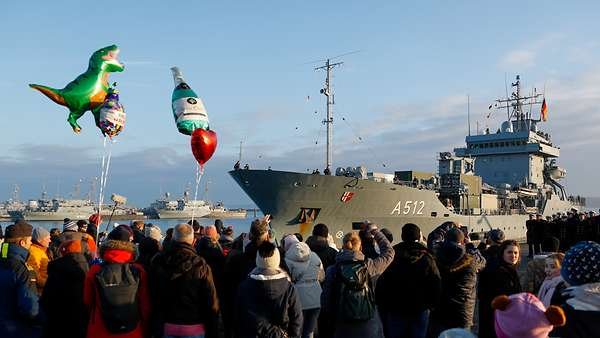After participating in NATO’s operational units, the “Mosel”, “Sulzbach-Rosenberg” and “Spessart” returned at the beginning of December. Return to their home port in time for the holidays.
The crews left Kiel in July for various operational areas. While the minesweeper “Sulzbach-Rosenberg” sailed to the eastern Mediterranean, the tender “Mosel” remained for the first time in the area of the Atlantic coast off the Iberian Peninsula.

But in these times, planned things can change quickly. The 45-strong crew of the “Sulzbach-Rosenberg” also had to experience this. Prepared for warm temperatures in the Mediterranean, it went back north by NATO order. “The change from 38 to 0 degrees Celsius was a bit challenging, at least as far as the selection of clothing was concerned,” says Lieutenant Commander Florian Förster, commander of the minesweeper. But here, too, the Navy was flexible. During a short stop in Hamburg, the crew was able to quickly exchange uniforms and civilian clothing from summer to winter clothing.
After a total of 14,500 nautical miles and 17 ports in ten countries, the commander sums up the voyage: “For the third mission in three years, the performance was consistently very good and professional. On an international level, we were able to show what we can do.”
The tender “Mosel” was the lead ship of NATO’s permanent mine countermeasures unit, SNMCMG Standing NATO Mine Countermeasures Group 1, in the North Sea and Baltic Sea. During this time, he covered more than 10,000 nautical miles. In addition to the 68 crew members, soldiers from up to six different nations of an international staff were additionally embarked on board. “One of the absolute highlights during this trip was the arrival in London, the passage of the Tower Bridge in the dark and docking at the famous cruiser HMS Belfast,” said the commander of the tender, Lieutenant Commander Stefan Ladewich.
But there were also difficult situations on the trip, which were handled professionally by the entire crew. For example, the first explosion of a mine by a shipped American EOD Explosive Ordnance Disposal Team (Explosive Ordnance Disposal) as well as short-term flight operations at night in the Finnish Archipelago landscape. Here, an injured French comrade was flown to hospital by a Finnish rescue helicopter. All this is one of the commander’s lasting memories.

